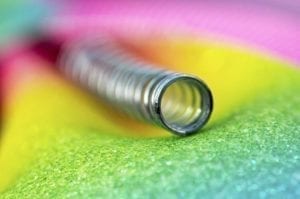 A spring is an elastic device or component that is manufactured by a spring company for numerous industrial applications. Most have a helical or coil shape with many design functions, depending on the application, to maintain a force between objects or contacting surfaces, or to exert or absorb a shock. Springs store and release mechanical energy and are governed by Hooke’s law of physics, i.e., the force a spring exerts—whether a push or pull motion—is proportional to its extension. Though springs can be made with a variety of materials, most are manufactured with spring steel wire. The three most common types of springs are compression, torsion, and extension. Want to learn more about springs? Below are five fun and interesting facts about springs and their uses.
A spring is an elastic device or component that is manufactured by a spring company for numerous industrial applications. Most have a helical or coil shape with many design functions, depending on the application, to maintain a force between objects or contacting surfaces, or to exert or absorb a shock. Springs store and release mechanical energy and are governed by Hooke’s law of physics, i.e., the force a spring exerts—whether a push or pull motion—is proportional to its extension. Though springs can be made with a variety of materials, most are manufactured with spring steel wire. The three most common types of springs are compression, torsion, and extension. Want to learn more about springs? Below are five fun and interesting facts about springs and their uses.
The Invisible Component
Springs are such a common, ubiquitous component that they often operate in plain sight without notice. Few think that the trajectory of an arrow, the bounce of a trampoline, the stability of a car, a simple mousetrap or shutting of a screen door all rely on the mechanical energy stored in a spring to function. In fact, nearly any manufactured product that involves a mechanism is more than likely to have a spring component in it. Machinery of all types and sizes are not only manufactured and assembled with spring components but spring components are often found in the devices that are being assembled and manufactured by that machinery.
Medical Applications
One of the most important components in the manufacturing of medical devices and equipment throughout the medical industry is springs. They are indispensable to some of the most common as well as advanced medical equipment used today. They are found in noninvasive applications as diagnostic and monitoring devices, syringes, and pill dispensers, but also are found in such surgical and nonsurgical devices as pacemakers and catheters. Some medical applications for springs require micro-dimensions manufactured down to 0.03 millimeters in wire size for arterial widening.
Springs Were Integral to the Age of Discovery
Without accurate timekeeping, the Age of Discovery may have been a bit haphazard. Helical or coiled springs were developed in the early fifteenth century to power clocks. Before, clocks were operated and powered by a system of weights. With the development of a coiled spring mechanism, clocks could be powered with a wound spring. This advanced portable timekeeping devices. In doing so, precise celestial navigation was made possible for ocean-going vessels.
Springs and Technology
As the computer and cellular phone technology expand, micro-spring technology is continually being developed by spring manufacturers. Springs already support keys on touchpads and keyboards, but they are being tested for semiconductor applications. Micro-spring contact technology is being tested in semiconductor production. Thousands of tiny 40 mil high springs are being used to bond individual contact points of semiconductor wafers. When the springs are compressed, the wafer establishes a highly reliable electrical connection.
Compression Spring Coils Never Touch
Compression springs are designed in many configurations, shapes and sizes. For example, some are conical, hourglass or barrel and of varying lengths. They can be used as a shock absorber, vibration damper, a pure energy accumulator, or generate force. However, in order to function as designed, the coils of a compression spring must not come in contact with each other when the spring is compressed. If they touch, it is a sign that the service life of the spring has ended and needs to be replaced.
Springs are an exceptionally versatile component. They not only store energy efficiently but are manufactured in multiple shapes and sizes for a wide selection of applications. James Spring and Wire Company is an industry leader in the design and manufacture of standard and custom springs. Decades of experience combined with state-of-the-art custom spring manufacturing capabilities provide cost-effective solutions and the best spring for the application.

